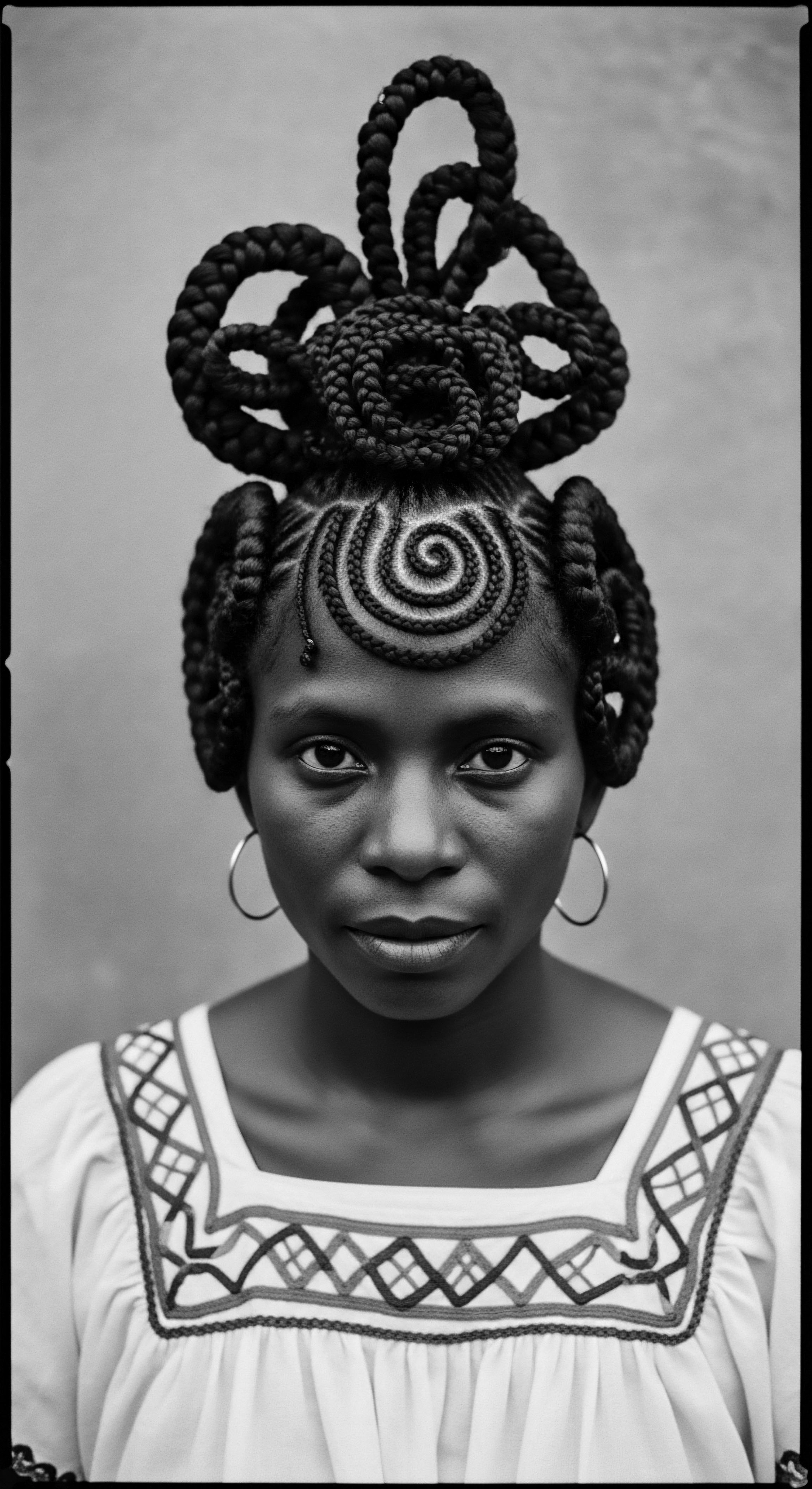
Fundamentals
Dietary Wisdom, at its simplest, denotes the conscious understanding that what we consume profoundly affects our physical being. It represents an awareness of the body’s intrinsic needs and how specific foods or eating patterns contribute to overall vitality. For hair, this foundational understanding means recognizing that a healthy scalp and strong strands are not merely a matter of topical care. They stem directly from the deep nourishment provided by the foods entering our bodies.
The principle suggests a simple truth ❉ our hair, much like the branches of an ancient tree, draws its life from the roots – in this context, the nutrients absorbed through our digestive system. Without essential building blocks, the hair’s resilience, its growth, and its very texture can falter. This primary comprehension of sustenance lays the groundwork for deeper exploration, hinting at the ancestral knowledge that recognized this connection long before modern science articulated the precise mechanisms.
Dietary Wisdom is the fundamental recognition that internal nourishment directly shapes the vitality and character of our hair.

Nourishment as a Legacy
Across generations, particularly within Black and mixed-race communities, the practices of feeding oneself and one’s family were imbued with a wisdom passed down orally, through observation, and communal experience. Food was not merely calories; it embodied healing, celebration, and continuity. This ancestral knowledge often recognized connections between diet and visible health markers, including the luster and strength of hair. The communal pot and the shared meal represented a collective understanding of what sustained the body and spirit.
This initial grasp of Dietary Wisdom serves as an echo from the source, a foundational whisper across time that acknowledges food as the primary architect of well-being. It is a concept accessible to all, irrespective of scientific background, calling upon an intuitive understanding of the body’s profound relationship with its sustenance. This understanding of nourishment stands as a testament to the intuitive brilliance residing within traditional ways of living.

The Elemental Connection to Hair
Every strand of hair, from its deepest root to its vibrant tip, relies on a steady supply of nutrients. These include proteins, which are the fundamental components of keratin; vitamins such as A, C, D, and E; and an array of minerals, notably iron and zinc. These substances collectively contribute to the hair’s growth, its ability to resist damage, and the overall health of the scalp. Consider how ancestral communities, with limited access to modern supplements, often relied on nutrient-dense, whole foods to support robust health.
For textured hair, which often possesses unique structural attributes demanding specific care, the internal supply of these elements becomes even more significant. Hydration, too, plays a pivotal role in maintaining the hair’s suppleness and preventing breakage. This primary connection forms the bedrock of Dietary Wisdom, inviting us to look inward for true hair vitality, understanding that the health of our hair mirrors the richness of our internal environment.
- Proteins ❉ Essential for keratin production, forming the structural framework of hair.
- Vitamins A, C, E ❉ Offer protective qualities, guarding hair follicles from oxidative stress and supporting collagen creation.
- Iron ❉ Facilitates oxygen transport to hair follicles, crucial for growth cycles.
- Zinc ❉ Supports tissue repair and hormone regulation, influencing hair growth.
- Omega-3 Fatty Acids ❉ Promote scalp health and blood circulation, contributing to robust strands.

Intermediate
Moving beyond a simple acknowledgment, Dietary Wisdom, at an intermediate level, embodies a deeper comprehension of how nutritional patterns interact with genetic predispositions, environmental factors, and cultural legacies to shape our physiological expressions, including the very character of our hair. It delves into the holistic interplay, recognizing that sustenance is not a solitary act but a resonant dialogue between the individual, their lineage, and their environment. This perspective requires us to consider food as a powerful agent of self-definition and a conduit for ancestral memory.
This advanced stage of understanding acknowledges that the vitality of textured hair, with its unique structural needs, is inextricably linked to generations of eating traditions, shifts in food access, and the resilience of ancestral foodways. It invites a thoughtful inquiry into the subtle yet potent ways our daily sustenance weaves into the intricate story of our hair. The wisdom expands to encompass not just what we eat, but also the stories, rituals, and challenges intertwined with those choices.
Dietary Wisdom, for those seeking deeper understanding, illuminates the profound, often invisible, connections between ancestral foodways, cultural resilience, and the inherent character of textured hair.

Ancestral Plates, Resilient Strands
The journey of Black and mixed-race peoples across continents and through eras often involved dramatic disruptions to traditional diets, yet ancestral knowledge persisted, adapting and transforming. Consider the resilience demonstrated by enslaved Africans, who, despite forced relocation, managed to cultivate familiar dietary staples in their new environments, utilizing plants and food animals brought on slave ships. These adaptive foodways provided crucial nutritional support, even under oppressive circumstances, contributing to the survival and, indeed, the physical expressions of identity, such as hair.
Traditional African diets, prior to significant colonial influence, were often rich in plant-based proteins, diverse vegetables, healthy fats from nuts and seeds, and nutrient-dense grains. Leafy greens, root vegetables, fatty fish, and various legumes were commonplace, all contributing elements known to support robust health, including the underlying architecture of hair follicles. The continuation of these dietary principles, even in adapted forms, represented an act of cultural preservation and a quiet testament to their inherent wisdom.

The Rhythmic Dance of Sustenance
The body’s processes, including hair growth, operate in a continuous cycle, demanding consistent and balanced nourishment. Dietary Wisdom recognizes that sporadic or deficient intake can disrupt this delicate rhythm. For textured hair, which can be more prone to dryness and breakage due to its structural characteristics, a sustained supply of lipids, proteins, and water is paramount. The elasticity and strength of the strand are heavily reliant on these internal building blocks, a testament to the hair’s capacity to reflect internal harmony.
Ancient practices, often centered around seasonal eating and communal sharing, intuitively supported this rhythmic demand for nutrients. For instance, the consumption of particular traditional African foods like pumpkin leaves (Ugu) and amaranth, known for their iron, Vitamin A, and C content, directly supports sebum production and collagen creation, both vital for hair health and shine. The continuity of these practices, even in contemporary settings, speaks to an enduring understanding of food’s profound influence.
| Food Item Fatty Fish (Mackerel, Sardines) |
| Key Nutrients Omega-3 fatty acids, Protein |
| Hair Benefit Reduces scalp inflammation, supports follicle health, promotes hair growth. |
| Food Item Leafy Greens (Spinach, Amaranth) |
| Key Nutrients Iron, Vitamin A, Vitamin C |
| Hair Benefit Supports iron transport to follicles, aids sebum production, strengthens strands via collagen. |
| Food Item Legumes (Black-eyed Peas, Lentils) |
| Key Nutrients Plant-based Protein, Iron, Zinc |
| Hair Benefit Provides keratin building blocks, assists oxygen delivery, regulates growth cycles. |
| Food Item Sweet Potatoes |
| Key Nutrients Beta-carotene (converts to Vitamin A) |
| Hair Benefit Boosts sebum production, hydrates hair, protects against environmental damage. |
| Food Item These traditional foods, consumed across generations, underscore the deep, historical connection between dietary choices and hair vitality within African and diasporic communities. |

Academic
Dietary Wisdom, from an academic perspective, represents a transdisciplinary framework that systematically examines the intricate, reciprocal relationships between nutritional intake, physiological function, psychosocial well-being, and socio-cultural determinants, particularly as these factors manifest in the unique phenotypes and health trajectories of textured hair. This concept moves beyond rudimentary nutritional guidelines, embracing the complex interplay of genomics, epigenetics, historical food systems, and collective cultural practices that collectively shape our biological expressions. It posits that understanding the meaning of Dietary Wisdom requires a critical lens, one that accounts for the enduring effects of historical dispossessions and the profound resilience of ancestral foodways.
The meaning of Dietary Wisdom is not merely about what is consumed; it encompasses the genesis of food production, its distribution within communities, and the cultural contexts that dictate its preparation and consumption. It recognizes the profound impact of food environments, which, for many Black and mixed-race communities, have been systematically altered by historical and ongoing inequities. This sophisticated understanding requires a meticulous examination of how diet serves not only as a source of energy but as a potent carrier of identity, a marker of resistance, and a crucial determinant of hair and scalp health across the African diaspora.

Epigenetic Echoes and Nutritional Legacies
The impact of diet on hair extends beyond simple nutrient availability, touching upon the realm of epigenetics – how environmental factors, including nutrition, influence gene expression without altering the underlying DNA sequence. Chronic nutritional deficiencies or exposures to substandard diets over generations can leave an epigenetic imprint, potentially influencing hair growth cycles, shaft integrity, and even the susceptibility to certain hair conditions in subsequent generations. This profound observation connects contemporary hair challenges directly to ancestral food experiences.
Consider the historical imposition of highly restrictive diets on enslaved Africans in the Americas and the Caribbean. Their sustenance was often characterized by a heavy reliance on starchy foods like sweet potatoes and corn, with insufficient protein or fresh produce. Analysis of skeletal remains from sites such as the Newton plantation cemetery in Barbados reveals that enslaved individuals frequently suffered from malnutrition, particularly a lack of essential nutrients, for significant portions of the year.
This enduring dietary hardship, passed down through familial lines, could have contributed to intergenerational patterns of nutritional vulnerability, subtly yet powerfully shaping the physiological landscape within which textured hair developed. Such historical dietary trauma, repeated over centuries, necessitates a re-evaluation of modern hair health disparities, recognizing their deep historical roots.
The concept of “food colonialism,” as described by entities such as Project HEAL, highlights how colonial powers systematically disrupted indigenous food practices, replacing diverse, nutrient-rich traditions with cash crops and exploitative agricultural models. This historical exploitation led to the loss of ancestral knowledge and culinary traditions, actively eroding self-sufficiency. The residual effects of this systemic disruption can be observed in the current prevalence of “food apartheid” in many Black communities, where access to affordable, nutrient-dense foods remains limited. This constrained food environment, a direct legacy of historical injustices, continues to impede optimal hair health by limiting the very building blocks required for vibrant growth.
Academic Dietary Wisdom deciphers how historical food systems, inherited through generations, leave epigenetic imprints that influence the very vitality and character of textured hair.

The Sociology of Sustenance and Hair Identity
Dietary Wisdom, in an academic sense, also explores the socio-cultural meanings ascribed to food and how these meanings intersect with racial identity and beauty standards, particularly for Black and mixed-race individuals. The concept of “soul food,” for example, initially emerged during the Black Power movement as a symbol of strength, pride, and a connection to African roots, serving as a powerful cultural marker despite its evolving nutritional profile in modern times. This cultural significance of food transcends its mere caloric value, functioning as a vehicle for collective memory, celebration, and resistance against dominant narratives that historically devalued Black bodies and their aesthetic expressions, including hair.
Yet, the narrative surrounding soul food has also undergone scrutiny, as elements popularized in the mainstream, such as fried chicken and macaroni and cheese, often descended from a “colonized cuisine” based on leftover scraps from enslavers. This nuanced understanding reveals that while food practices can be a source of pride, they can also reflect a complex history of adaptation under duress. The “decolonize your diet” movement, which advocates for a return to pre-colonial Indigenous and Black eating patterns, represents a contemporary expression of Dietary Wisdom, aiming to reclaim health and heritage by dismantling the lingering effects of food colonialism. This movement directly impacts hair health by prioritizing nutrient-dense ancestral foods.

Intergenerational Memory on the Plate
The choices made regarding food, particularly within communities grappling with historical trauma and systemic marginalization, can carry deep symbolic weight. For instance, the disproportionate rates of diet-related diseases among Black Americans today directly correlate with the systemic targeting of their communities with cheap, low-fiber, high-calorie fast foods, a pattern that began after 1970. Before this proliferation, 1965 dietary surveys revealed that African Americans in cities were twice as likely to meet dietary recommendations for fruits, vegetables, and fiber compared to the general U.S. population, demonstrating a fiber-rich culinary heritage that survived centuries of adversity.
This shift in food access and consumption, a direct consequence of institutional policies, underscores how societal structures can profoundly impact the embodied expressions of health, including hair. The physical manifestation of hair vitality thus becomes a living archive, bearing the marks of both historical struggle and profound resilience. The academic exploration of Dietary Wisdom calls for a recognition of these deep currents, inviting us to view each strand of hair as a testament to an ongoing dialogue between ancestry, environment, and intentional nourishment.
Within this comprehensive understanding, Dietary Wisdom is not static; it is a dynamic, evolving construct that requires constant re-evaluation through interdisciplinary lenses. It is an acknowledgment that true health, reflected in the strength and vibrancy of textured hair, arises from an informed respect for the past, a critical engagement with the present, and a mindful cultivation of the future through conscious dietary choices. This means embracing nutritional science while remaining reverent of ancestral foodways and acknowledging the social, economic, and political forces that have shaped access to sustenance for generations.
The interconnection between diet and hair health is scientifically well-documented, with various nutritional deficiencies leading to issues such as thinning, breakage, and loss. For example, a lack of iron can lead to significant hair shedding, as iron carries oxygen to hair follicles, which are essential for growth. Similarly, insufficient intake of B vitamins, especially biotin, can result in brittle or thinning hair, as these vitamins play a crucial role in keratin production. The resilience of textured hair, in particular, depends on a consistent supply of these fundamental nutrients, which are often compromised in diets that deviate from traditional, whole-food patterns.
- Folic Acid (Vitamin B9) ❉ Aids in cell growth and development, supporting hair follicle replication.
- Vitamin D ❉ Involved in the creation of new hair follicles and the cycling of hair growth.
- Vitamin C ❉ Essential for collagen synthesis, which is a protein that provides structure to hair.
- Copper ❉ Plays a role in melanin production, influencing hair pigmentation and possibly structural integrity.
- Selenium ❉ An antioxidant that supports overall scalp health.

Reflection on the Heritage of Dietary Wisdom
As we draw this meditation to a close, a powerful truth emerges ❉ Dietary Wisdom is far more than a set of dietary rules or nutritional guidelines. It stands as a living testament, a whisper across centuries that speaks of resilience, adaptation, and an enduring connection to the earth and our ancestors. For those who carry the legacy of textured hair, the story of sustenance is inextricably intertwined with the very soul of each strand. Our hair, a vibrant crown, reflects not only the nutrients absorbed from our plates but also the profound history etched into our foodways.
The journey of Dietary Wisdom, from the elemental biology that shapes each follicle to the complex cultural narratives woven through generations of eating, is a continuous unfolding. It reminds us that our bodies hold ancestral memory, and our dietary choices can be a conscious act of reverence, a tender thread connecting us to the practices and wisdom of those who came before. In a world often disconnected from its natural rhythms, rediscovering this wisdom allows us to reclaim a part of ourselves, honoring the deep heritage that flows in our veins and blossoms in our hair.
The future of textured hair care, then, looks not only forward to scientific advancements but also deeply backward, recognizing the profound efficacy of traditional approaches. It invites a harmonious blend of inherited knowledge and contemporary understanding, creating a path to holistic well-being that nurtures both the body and the spirit. Each meal becomes an opportunity for connection, a chance to infuse our being with the rich legacy of our forebears, allowing our hair to thrive as a visible expression of this profound, unbroken lineage.

References
- Bower, Anne L. African American Foodways ❉ Explorations of History and Culture. University of Illinois Press, 2007.
- DeFelice, Stephen L. “The NutraCeutical Revolution ❉ Foods as Medicine.” The Nutraceutical Revolution, 1989.
- Mihesuah, Devon Abbott. Recovering Our Ancestors’ Gardens ❉ Indigenous Recipes and Guide to Decolonized Eating. University of Nebraska Press, 2020.
- Twitty, Michael W. The Cooking Gene ❉ A Journey Through African American Culinary History in the Old South. Amistad, 2017.
- Banks, Ingrid. Hair Matters ❉ Beauty, Power, and the Politics of Hair in African American Women’s Lives. New York University Press, 2000.
- Carney, Judith A. and Richard Nicholas Rosomoff. In the Shadow of Slavery ❉ Africa’s Botanical Legacy in the Atlantic World. University of California Press, 2009.
- Williams, Cicely D. “Kwashiorkor ❉ A Nutritional Disease of the African Child.” The Lancet, 1935.
- Strauss, Claudia, and Naomi Quinn. A Cognitive Theory of Cultural Meaning. Cambridge University Press, 1997.
- Theriault, Marilyn. From the Kitchen to the Parlor ❉ Language and Becoming in African American Women’s Hair Care. Oxford University Press, 2022.
